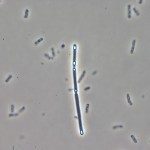Lien vers Pubmed [PMID] – 23676437
Microbiology (Reading, Engl.) 2013 Jul;159(Pt 7):1510-20
Primary antibiotic treatment of Clostridium difficile intestinal diseases requires metronidazole or vancomycin therapy. A cluster of genes homologous to enterococcal glycopeptides resistance vanG genes was found in the genome of C. difficile 630, although this strain remains sensitive to vancomycin. This vanG-like gene cluster was found to consist of five ORFs: the regulatory region consisting of vanR and vanS and the effector region consisting of vanG, vanXY and vanT. We found that 57 out of 83 C. difficile strains, representative of the main lineages of the species, harbour this vanG-like cluster. The cluster is expressed as an operon and, when present, is found at the same genomic location in all strains. The vanG, vanXY and vanT homologues in C. difficile 630 are co-transcribed and expressed to a low level throughout the growth phases in the absence of vancomycin. Conversely, the expression of these genes is strongly induced in the presence of subinhibitory concentrations of vancomycin, indicating that the vanG-like operon is functional at the transcriptional level in C. difficile. Hydrophilic interaction liquid chromatography (HILIC-HPLC) and MS analysis of cytoplasmic peptidoglycan precursors of C. difficile 630 grown without vancomycin revealed the exclusive presence of a UDP-MurNAc-pentapeptide with an alanine at the C terminus. UDP-MurNAc-pentapeptide [d-Ala] was also the only peptidoglycan precursor detected in C. difficile grown in the presence of vancomycin, corroborating the lack of vancomycin resistance. Peptidoglycan structures of a vanG-like mutant strain and of a strain lacking the vanG-like cluster did not differ from the C. difficile 630 strain, indicating that the vanG-like cluster also has no impact on cell-wall composition.

